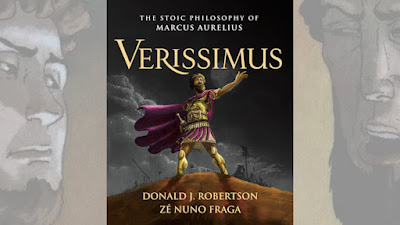Book Review: Verissimus: The Stoic Philosophy of Marcus Aurelius
Review By Casey Douglass
Just over three years ago, Donald Robertson’s How To Think Like A Roman Emperor released, a book that taught the reader about Stoic philosophy by way of describing the life of one of its greatest adherents: Marcus Aurelius. Donald’s latest book Verissimus: The Stoic Philosophy of Marcus Aurelius sees him teaming up with illustrator Zé Nuno Fraga to depict the philosophical journey of Marcus Aurelius in a new, eye-catching graphic novel format.
You’ve probably heard the name of Marcus Aurelius, but you might not know much about him. Marcus was one of the most famous ancient Stoics, one that also became the most powerful man in the known world when he took up the position of Roman emperor. Even though he showed unusual promise as a truthful and remarkably wise child, Marcus still had to work hard at developing his character, living wisely, and juggling the massive demands put upon him as ruler. He wrote his own book The Meditations to help with his efforts to keep himself on course.
.jpg) |
| Marcus being advised to embody his philosophy, rather than simply appearing to live it. |
Verissimus begins with Marcus on his deathbed, dying of the plague. He is being attended to by his physician, his family and his closest advisors. The very first image is of Marcus alone, in an incense clouded room. When I reached this page, I was a little startled after I realised how long I’d been looking at the scene. It seemed lonely, yet peaceful. Serious, yet expected. The ‘expected’ part solidifies as Marcus’ thinks and interacts with those who visit. He has been expecting this for so long, he has no fear of death. He sees it as a process of nature, and nothing natural needs to be feared. This is a great foreshadowing of the Stoic idea of ‘living according to nature’ and is something that we get to witness as Marcus’ life story unfolds.
Verissimus is split into fourteen sections, each touching on an important element or period in Marcus’ life. The reader gets to see him as a young child, particularly how he is tutored and raised. We get to see his love of philosophy and his aversion to becoming emperor. Once emperor, Marcus has to deal with war, plague and politics, alongside his own familial troubles and tragedies. I particularly enjoyed seeing the relationship that he had with his brother and co-emperor Lucius, as Marcus and he have such different characters, that it really helps to emphasise how different Marcus was from what was ‘normal’ for the time. Another element that I was glad to see in the graphic novel was Apollonius the Stoic’s relating of the choice of Hercules, a tale that tells of when Hercules has to choose between an easy life, or one of excellence and virtue. There are many other fascinating moments to feast your eyes upon, but I’m happy to see that the events that most surprised or stuck with me from How To Think Like A Roman Emperor made it across.
.jpg) |
| The beginning of the Hercules story. |
In the preface, Donald points out that Verissimus isn’t intended to be an introduction to Stoic philosophy, but a way to depict the ways in which Marcus Aurelius actually lived his philosophical beliefs. Donald says that his previous books, such as How To Think Like A Roman Emperor, are hopefully more apt as an introduction to Stoicism. If you are new to Stoicism or Marcus Aurelius, Verissimus is a tremendous way to begin to learn about both. If it really tickles your fancy and you want to read more in-depth information, you can then jump into How To Think Like A Roman Emperor for even more details, alongside comparisons with some aspects of modern therapy and how it sometimes uses similar approaches to the Stoics.
What about if you are coming to Verissimus after having read other Stoic works, particularly How To Think Like A Roman Emperor, such as in my own case? Will seeing Marcus’ life in graphic novel form bring anything new for you? I think that Donald sums up the power of the imagery best in his afterword. After seeing Marcus’ son Commodus depicted in visual form, Donald says that he began to view him in a somewhat different way. Donald has spent around twenty five years researching these topics. For a change of media to show him something differently in his own work... I think that’s more than a testament to the quality of the illustration and the power of Verissimus as a graphic novel. Personally, I feel that the imagery brings the life of Marcus, and various elements of Stoic philosophy, into a rich and vibrant level of clarity, and it does this in a way that’s as enjoyable as it is educational.
.jpg) |
| A Stoic lesson on indifference and our automatic reactions. |
Visit the Verissimus page at this link for more information, or copy and paste the ISBN below into your book website of choice.
If you'd like to read my review of Donald's How To Think Like A Roman Emperor, you can find that at this link.
Thank you to St. Martin’s Press for sending me an advance review copy of the book.
Book Title: Verissimus: The Stoic Philosophy of Marcus Aurelius
Book Author: Donald Robertson
Book Illustrator: Zé Nuno Fraga
Publisher: St. Martin’s Press
ISBN: 9781250270955
RRP: $32.50 U.S / £25 U.K (hard-cover)
Releases: 12 July 2022 U.S / 19 July 2022 U.K (hard-cover)

